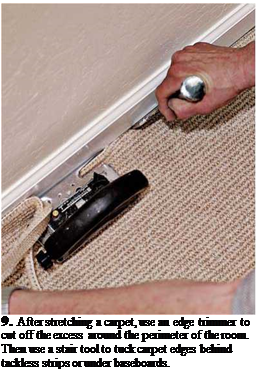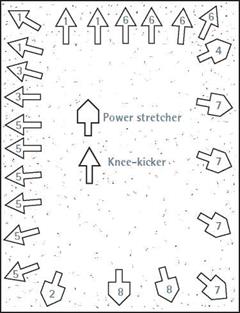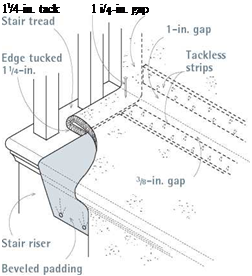STRETCHING CARPET
Once the carpet seams have cooled, stretch and attach the carpet to the tackless strips around the perimeter of the room, using the knee-kicker, power stretcher, and stair tool. Actually, if you must join carpet seams, you already will have used the knee-kicker to draw the carpet edges taut so the glued seam will be a straight.
Typically, stretching begins in a corner, using a knee-kicker. Place the knee-kicker about 1 in. from the wall and rap the cushion of the tool
 That’s pretty much it. Once the second corner is attached, alternate using the knee-kicker and the power stretcher, somewhat as shown in "A Carpet-Stretching Sequence,” below. There’s no one always-best sequence. Keep an eye on what the carpet is doing, and use the tool that seems right. Seen from above, your carpet-stretching movements would resemble something between a tennis match and icing a cake. Back and forth, fine tuning as you go.
That’s pretty much it. Once the second corner is attached, alternate using the knee-kicker and the power stretcher, somewhat as shown in "A Carpet-Stretching Sequence,” below. There’s no one always-best sequence. Keep an eye on what the carpet is doing, and use the tool that seems right. Seen from above, your carpet-stretching movements would resemble something between a tennis match and icing a cake. Back and forth, fine tuning as you go.
 Once the carpet is secured to the tackless strips and the transition pieces in the doorways, use an edge trimmer to remove the excess; trimmers also tuck the edge of the carpet to a degree. After trimming the edge, go around the perimeter with a hammer and a stair tool, tamping the carpet between the tackless strips and the wall, or under the baseboard trim. It’s important that the trimmer’s blade be sharp, so change razors whenever the tool drags, rather than cuts.
Once the carpet is secured to the tackless strips and the transition pieces in the doorways, use an edge trimmer to remove the excess; trimmers also tuck the edge of the carpet to a degree. After trimming the edge, go around the perimeter with a hammer and a stair tool, tamping the carpet between the tackless strips and the wall, or under the baseboard trim. It’s important that the trimmer’s blade be sharp, so change razors whenever the tool drags, rather than cuts.


quickly with your knee. When done properly, this maneuver carries the carpet forward and onto the points of the tackless strips. Then use the stair tool to pack the carpet into the small gap between the strips and the wall, also to securely lodge the carpet on the tack point. Knee-kicking takes a little practice. But, as more of the carpet is attached, and there is some tension on it, the task becomes easier. As you work along an edge of the carpet, rest your hand on the section just attached. The extra weight will prevent the section from being dislodged by successive knee-kicks.
After securing a corner 2 ft. to 3 ft along each wall, assemble the power stretcher to stretch the carpet to an adjacent corner across the room. To do this, place the tail end of the power stretcher on a 2×4 block resting along a baseboard of the corner you just attached; the 2×4 prevents the tail end of the stretcher from damaging the finish wall. Unlike the knee-kicker, which rebounds, the stretcher has a lever that extends the tool and holds it there until the lever is released. Before you engage the stretcher’s lever, place the stretcher head 5 in. or 6 in. from the wall you’re pushing the carpet toward. Once you push down on the lever, the stretcher head should move the carpet about 2 in. forward, leaving you plenty of room to use the stair tool and secure the carpet to the tackless strip.
I A Carpet-Stretching Sequence









Leave a reply